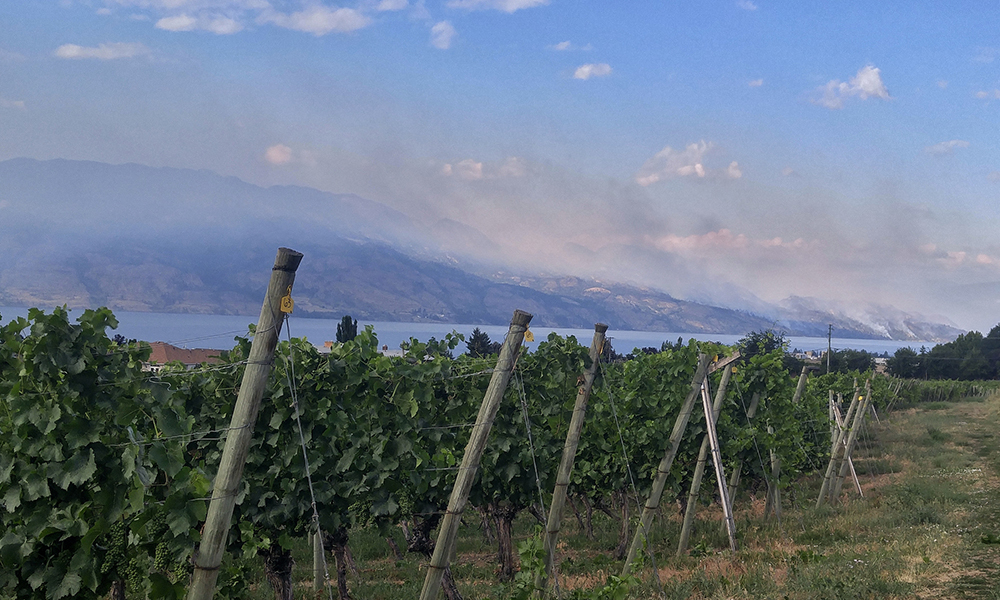
Researchers from UBC Okanagan are striving to better understand how to measure wines impacted by wildfire smoke.
As climate change continues to intensify wildfire season in British Columbia, the heavy smoke that frequently settles over vineyards can seep into the grapes and create ashy, smoky or medicinal-tasting wine.
New UBC Okanagan research examines how these wines are being tested and suggests a better chemical marker for predicting smoke taint.
Dr. Wesley Zandberg, an Associate Professor of Chemistry in the Irving K. Barber Faculty of Science, collaborated on new research published recently in the journal Molecules. Key participants in this project included researchers at Kelowna-based Supra Research and Development and the University of Adelaide.
The teams studied 10 Okanagan wines produced in 2018, a serious fire season. All wines were perceptibly influenced by smoke exposure. Three wines were on the market but identified as “smoke affected” and seven were never marketed because of the high levels of smoke taint detected after fermentation.
Researchers sent these tainted wines—as well as model wines deliberately fortified with carefully determined concentrations of chemicals linked to the aroma of smoke—to nine commercial and research laboratories around the world to compare concentration results and assess testing accuracy.
The nine laboratories had very similar—and accurate—results in calculating the concentrations of generally accepted markers of smoke taint like guaiacol and 4-methylguaiacol.
However, they had much lower accuracies for other volatile phenols and particularly for free cresols—a class of related compounds. Not only were the laboratories less accurate in identifying these free cresols, but the calculated concentrations of these free cresols in the tainted wines varied significantly between each lab.
“It’s important to notice that just because these chemical markers of smoke taint are there and can be measured or tasted, that doesn’t mean you have a tainted product,” says Dr. Zandberg. “That’s why it’s important to distinguish between smoke-tainted and smoke-affected wine. Just because smoke can be perceived doesn’t mean necessarily the wine is tainted, since this can be subjective.”
For example, people might appreciate the taste or smell of smoke in wine. Smoke can add to a wine’s profile depending on the balance of other tastes and consumer preferences, he says. However, if the smoke taste is beyond what a majority of people would enjoy, it becomes smoke tainted.
The paper notes that some volatile phenols naturally occur at high levels in certain species of grapes like Shiraz, which is associated with a peppery taste. Guaiacol can also be present in significant levels after wine matures in oak barrels.
In a related project, Dr. Zandberg’s team is currently working on defining the normal levels of naturally occurring phenols in years unaffected by wildfire smoke.
These sensory evaluations included the smoke-tainted Okanagan wines along with several untainted Australian vintages.
Judges differentiated between fruitiness and acidity and the sensory evidence of smoke exposure, like cold ash, medicinal or burnt rubber aromas and flavours, as well as an ashy aftertaste.
Interestingly, concentrations of free cresols—the same compounds that the laboratories were least accurate in identifying—were most strongly correlated to the taste and smell of smoke taint in the sensory tests.
Wildfire smoke will continue to impact Okanagan vineyards and those around the world, Dr. Zandberg says. While the taint will vary between regions, because it is determined by the vegetation that has been burnt, his ongoing research will help wine producers better protect their products.
“This kind of research is valuable because it can provide more accurate and more regionally relevant risk assessment tools,” says Dr. Zandberg. “It can importantly help wine producers connect chemical measurements to the taste and smell of their product, and that leads to improved ways to potentially mitigate this problem and reduce smoke taint in Okanagan wines.”